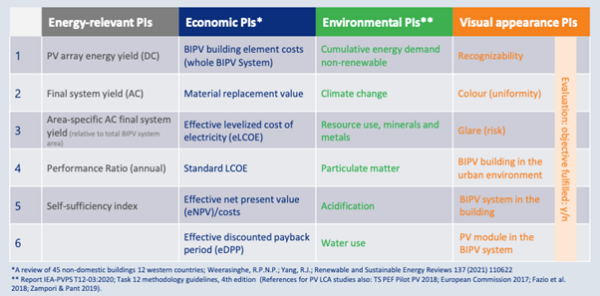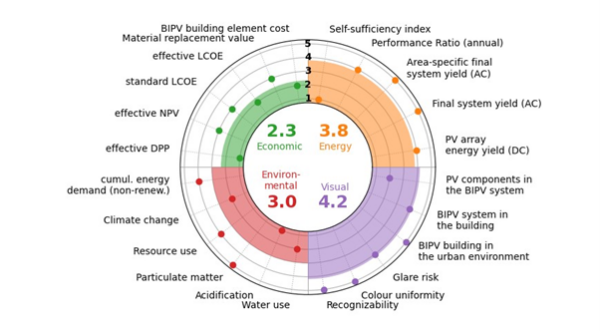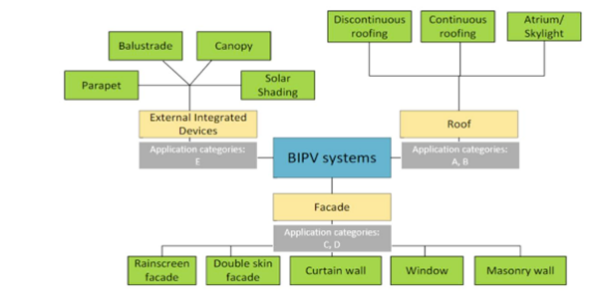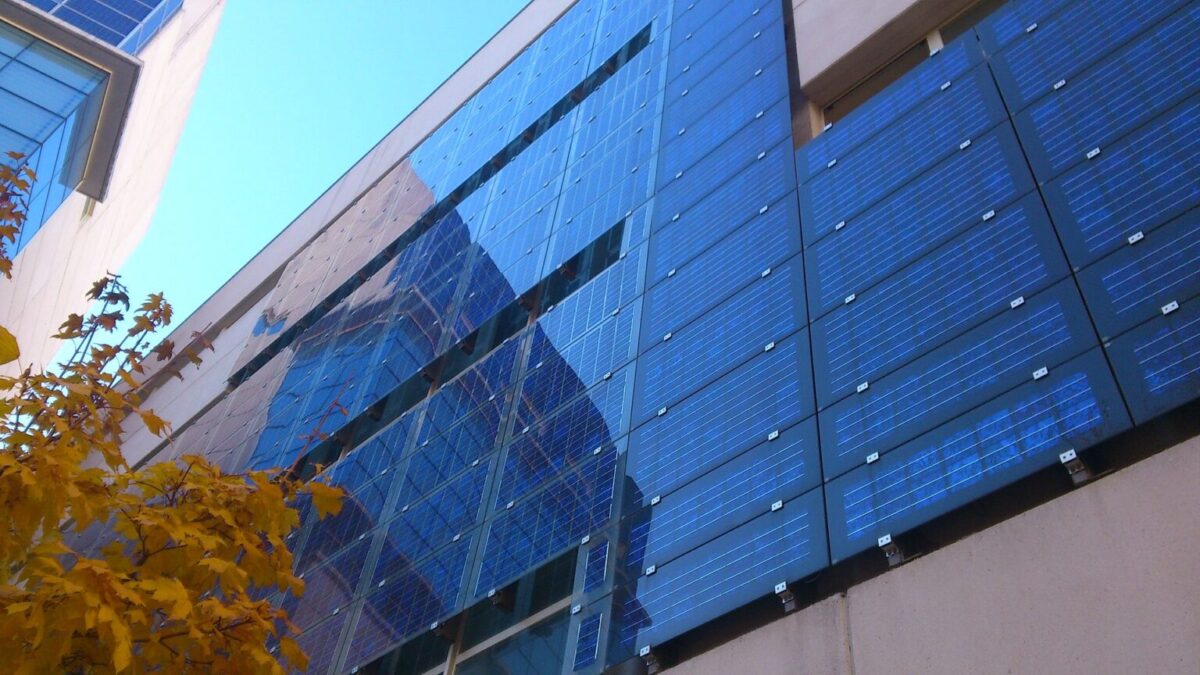The Fusion of Functionality in BIPV
Building-integrated photovoltaics (BIPV) holds huge potential for the future of the building industry, as it represents a pivotal intersection of electricity generation and building functionality. However, to identify the potential of BIPV installations in detail, the need for an evaluation tool becomes apparent. Recognizing the multifunctional nature of BIPV installations—acting as electricity generators, building components, and contributors to visual aesthetics—the IEA-PVPS Task 15 adopts a multidimensional approach for comprehensive evaluation.
Defining and Rating of Performance Indicators
To assess the quality and efficiency of BIPV systems, a set of performance indicators (PIs) was established in four categories: Economic, Energy-relevant, Environmental, and Optical/Visual Appearance. The PIs range from BIPV building element costs to recognizability and glare risk (see Figure 1).

Image: IEA-PVPS
Subsequently, a numerical rating system, ranging from 1 to 5, was established for each performance indicator. The process involved defining possible ranges based on real installations, setting a scale for each PI, calculating mean-rated PIs for each category, and visualizing the results in a newly developed diagram format (see Figure 2 for an example). This step ensures a quantifiable and comparative analysis of diverse BIPV installations.

Multi-Dimensional Evaluation Tool
The heart of the methodology lies in the Multi-Dimensional Evaluation Tool. This tool requires specific data on installation sites (geographical, climatic, orientation, inclination, shading), PV modules (datasheet), BIPV installations (application and system category, sub-system, building type, total installed area and total nominal power of the BIPV building skin, photos), and rated performance indicators. By combining general information and performance indicators, stakeholders can assess the multifunctional performance of a BIPV installation in terms of energy, economy, environment, and visual appearance.
Harmonized vocabulary for BIPV installations
To ensure a standardized approach, a harmonized vocabulary for BIPV installation types has been developed by IEA PVPS Task 15 experts. This optimized hierarchical approach serves as a reference for the classification of BIPV building envelope technology, facilitating a comprehensive breakdown into individual parts (see Figure 3).

Multi-Functional Evaluation of BIPV Cases
To validate the tool, real BIPV installations representing various building typologies were identified. These included a multifamily apartment complex with a camouflaged BIPV facade, an office building with BIPV elements, BIPV roofs of terrace houses, and a multifamily apartment block with BIPV parapets and window balustrades. Experts conducted a preliminary analysis of representative building typologies to test and validate the methodology. The assessment covered BIPV facades, roofs, and external devices. Results showcased the tool’s efficacy in providing a comprehensive understanding of BIPV installations, including visual performance.
Challenges and Difficulties
The journey towards a comprehensive BIPV evaluation methodology was not without challenges. Issues such as data availability, the subjective nature of aesthetic assessments, and the evaluation of lighthouse projects were encountered. Despite these challenges, the methodology underwent several improvement iterations, providing valuable insights into real-world applications.
Conclusions and Lessons Learned
IEA-PVPS Task 15’s multidimensional assessment methodology for BIPV systems represents a significant step forward. Through continuous learning cycles and real-world testing, the challenges posed by data availability, visual assessments, and project evaluation have been addressed. The methodology, showcased through real BIPV installations, serves as a valuable resource for architects, developers, and stakeholders involved in the design process of BIPV projects. As the BIPV landscape continues to evolve, this innovative evaluation approach paves the way for more effective and sustainable integration of photovoltaics into building structures.
For more information on IEA PVPS Task 15 and BIPV please click here.
The third phase of Task 15, to extend the activities for four years, is expected to start early in 2024. Participating in Task 15 can be one way of influencing BIPV standardization without the formal membership of a standardization committee. In case you are a potential participant of Phase 3 of Task 15, please contact the Phase 2 Task Co-Managers Francesco Frontini (for contributions relating to the topics of “Challenges and opportunities of BIPV in a de-carbonized and circular economy”, “BIPV in the digital environment”, “BIPV products, projects and demos: innovation and long-term behavior” and “BIPV training, dissemination and stakeholders’ collaboration”) and Helen Rose Wilson (for contributions relating to the topic of “BIPV characterization & performance: pre-normative international research”)
This article is part of a monthly column by the IEA PVPS programme. It was contributed by IEA PVPS Task 15 – Enabling Framework for the Development of BIPV.
Author: Bettina Sauer
The views and opinions expressed in this article are the author’s own, and do not necessarily reflect those held by pv magazine.
This content is protected by copyright and may not be reused. If you want to cooperate with us and would like to reuse some of our content, please contact: editors@pv-magazine.com.








By submitting this form you agree to pv magazine using your data for the purposes of publishing your comment.
Your personal data will only be disclosed or otherwise transmitted to third parties for the purposes of spam filtering or if this is necessary for technical maintenance of the website. Any other transfer to third parties will not take place unless this is justified on the basis of applicable data protection regulations or if pv magazine is legally obliged to do so.
You may revoke this consent at any time with effect for the future, in which case your personal data will be deleted immediately. Otherwise, your data will be deleted if pv magazine has processed your request or the purpose of data storage is fulfilled.
Further information on data privacy can be found in our Data Protection Policy.